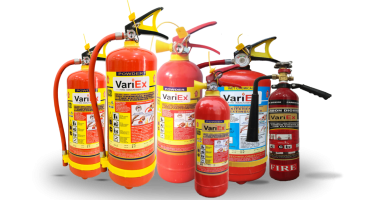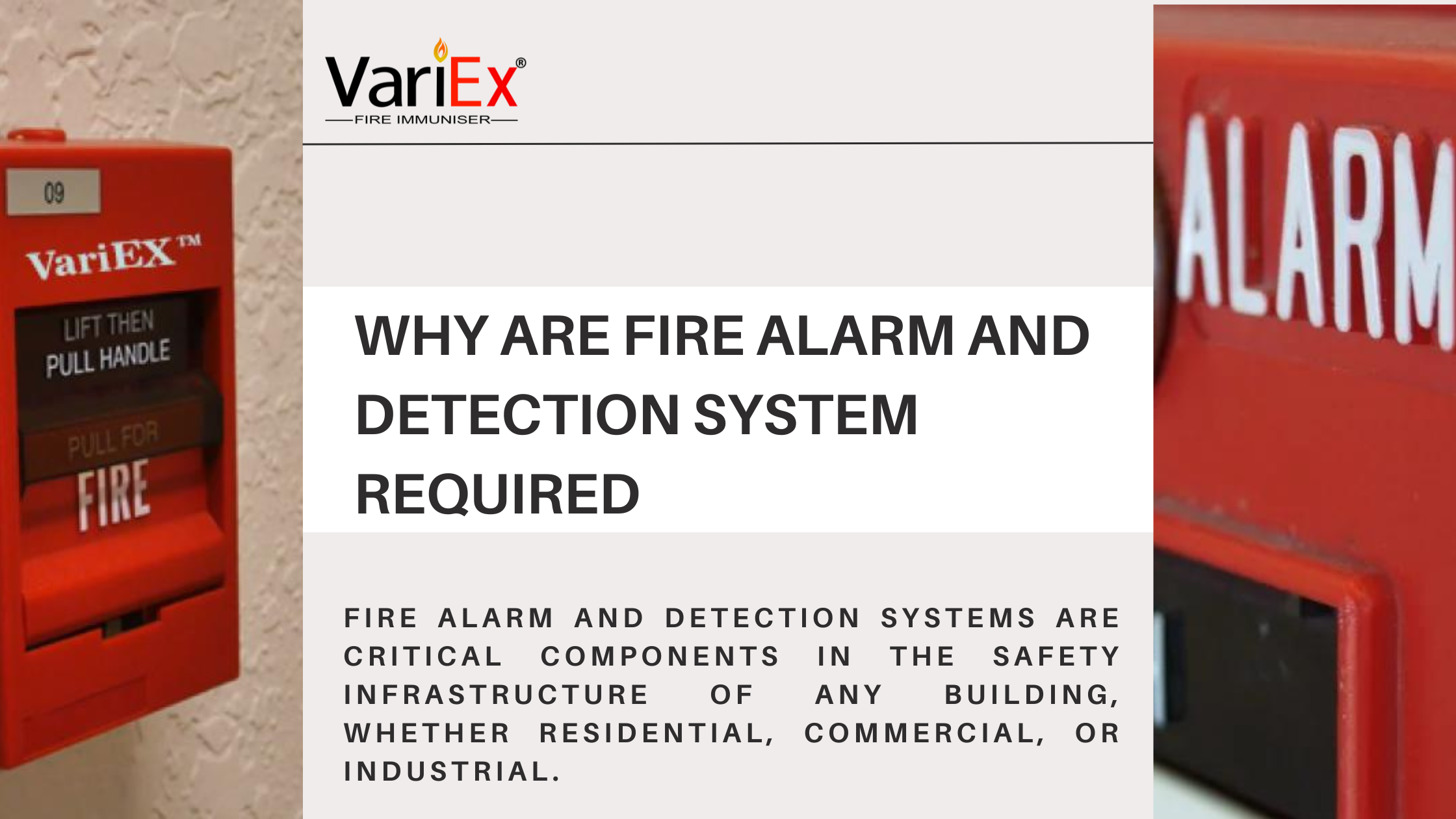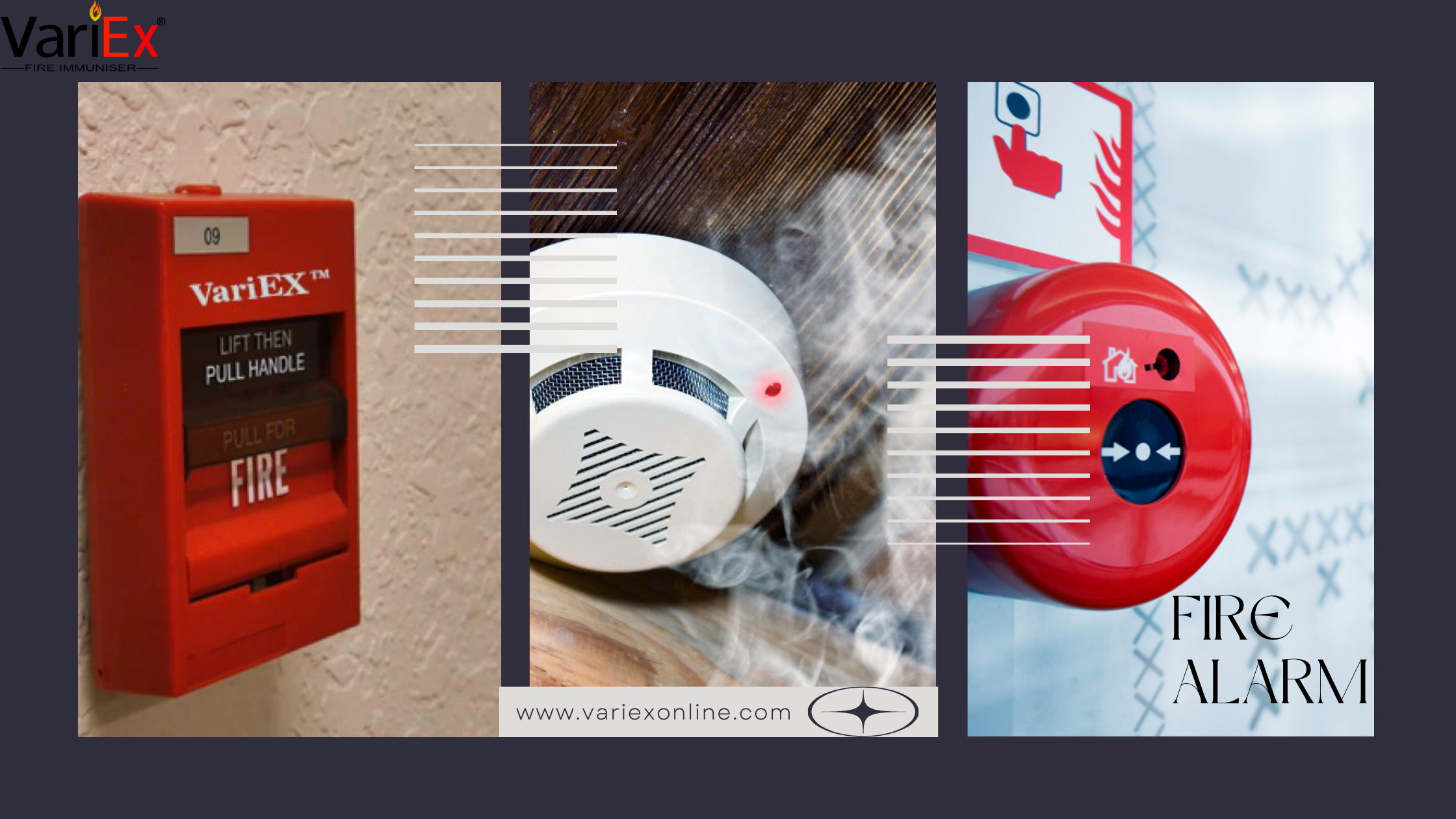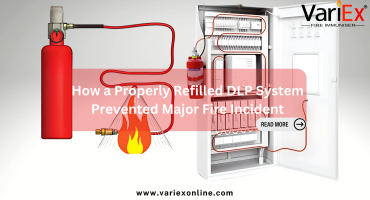![]()
Fire Immuniser
+91-7829629111
Email: info@variex.in
Varistor Technologies Pvt. Ltd.
Block-1, First Floor, Ardente Office One, Hoodi Circle, ITPL Main Road, Bengaluru, Karnataka 560048, IN
Why Are Fire Alarm And Detection System Required
Why Are Fire Alarm And Detection System Required
Fire alarm and detection systems are critical components in the safety infrastructure of any building, whether residential, commercial, or industrial. These systems are designed to detect the presence of fire and alert occupants and emergency services to prevent loss of life and minimize property damage. The importance of fire alarm and detection systems cannot be overstated, as they provide an essential layer of protection against the devastating effects of fires. This comprehensive article explores the necessity of fire alarm and detection systems, covering their functions, benefits, regulatory requirements, and advancements in technology.
Functions of Fire Alarm and Detection Systems
- Early Detection: The primary function of fire alarm systems is to detect fires at an early stage. This early detection is crucial for providing sufficient time to evacuate occupants and alert emergency responders.
- Notification: Fire alarms notify building occupants through audible and visual signals. These notifications are essential for initiating an orderly and timely evacuation, reducing panic, and ensuring that everyone is aware of the emergency.
- Emergency Response Coordination: Modern fire alarm systems are integrated with emergency response systems. They automatically notify local fire departments and emergency services, facilitating a swift response to control and extinguish the fire.
- Smoke Control and Ventilation: Advanced fire detection systems can control smoke and ventilation systems within a building. This helps manage smoke spread, improving visibility for evacuation and reducing inhalation risks.
- System Monitoring and Maintenance: Fire alarm systems continuously monitor for faults and issues. Regular maintenance ensures that the systems are functioning correctly, and any faults are promptly addressed.
Benefits of Fire Alarm and Detection Systems
- Life Safety: The foremost benefit of fire alarm systems is the protection of human life. By providing early warning, these systems ensure that occupants have enough time to evacuate safely, significantly reducing the risk of injury or death.
- Property Protection: Fire detection systems help minimize property damage by facilitating a quicker response to fire incidents. Early detection and prompt firefighting measures can prevent a small fire from escalating into a major disaster.
- Business Continuity: For businesses, fire alarms are crucial for continuity. Fire incidents can lead to significant financial losses, including damage to assets, loss of data, and operational downtime. Fire detection systems help mitigate these risks, ensuring that business operations can resume quickly after an incident.
- Insurance Benefits: Many insurance companies offer reduced premiums for properties equipped with functional fire alarm systems. This is because these systems lower the risk of extensive damage, making insured properties less risky.
- Compliance with Regulations: Fire alarm and detection systems are often required by building codes and regulations. Compliance ensures that buildings meet safety standards, avoiding legal penalties and fostering a safe environment for occupants.
Regulatory Requirements
Fire alarm and detection systems are governed by various regulations and standards to ensure their effectiveness and reliability. Key regulatory frameworks include:
- National Fire Protection Association (NFPA): The NFPA publishes standards such as NFPA 72, which outlines the requirements for the installation, testing, and maintenance of fire alarm systems.
- International Building Code (IBC): The IBC mandates fire alarm systems in certain types of buildings and occupancy classifications, specifying the necessary features and performance criteria.
- Local Building Codes: Local jurisdictions often have their building codes that may include additional requirements for fire alarm systems. It is essential to comply with these local regulations to ensure full compliance.
- Occupational Safety and Health Administration (OSHA): OSHA regulations may require fire alarm systems in workplaces to ensure employee safety and adherence to occupational health standards.
- Insurance Requirements: Insurance providers may have specific requirements for fire alarm systems as part of their underwriting criteria. Meeting these requirements can be crucial for obtaining and maintaining insurance coverage.
Advancements in Fire Alarm and Detection Technology
The field of fire alarm and detection systems has seen significant technological advancements, enhancing their effectiveness and reliability. Some notable advancements include:
- Wireless Fire Alarm Systems: Wireless systems eliminate the need for extensive wiring, reducing installation costs and improving flexibility in system design. They are particularly useful in historic buildings or locations where wiring is challenging.
- Intelligent Fire Detection: Modern systems incorporate artificial intelligence (AI) and machine learning algorithms to analyze data from sensors. These intelligent systems can differentiate between false alarms and actual fire incidents, reducing the likelihood of unnecessary evacuations.
- Integration with Building Management Systems: Fire alarm systems can be integrated with other building management systems, such as HVAC and security systems. This integration allows for coordinated responses, such as shutting down ventilation to prevent smoke spread or unlocking doors for evacuation.
- Enhanced Smoke Detection Technologies: Newer smoke detectors use advanced technologies such as laser-based detection and multi-sensor detectors. These technologies provide faster and more accurate detection of different types of fires.
- Remote Monitoring and Control: Cloud-based solutions enable remote monitoring and control of fire alarm systems. Building managers can receive real-time alerts and manage the system from anywhere, improving response times and system management.
- Voice Evacuation Systems: Instead of traditional alarms, voice evacuation systems provide clear instructions to occupants, reducing confusion and ensuring a more orderly evacuation.
Case Studies and Real-World Applications
Case Study 1: Grenfell Tower Fire, London
The Grenfell Tower fire in 2017 highlighted the critical importance of functional fire alarm and detection systems. The high-rise residential building lacked adequate fire detection and alarm systems, contributing to the rapid spread of the fire and the tragic loss of 72 lives. This incident led to widespread reforms in fire safety regulations, emphasizing the need for robust fire detection systems in residential buildings.
Case Study 2: MGM Grand Fire, Las Vegas
The MGM Grand fire in 1980 is another significant example. A fire broke out in the casino and spread to the hotel tower, resulting in 85 fatalities. The lack of a comprehensive fire alarm system and delayed detection contributed to the high death toll. Following this disaster, stringent fire safety regulations were implemented in hotels and casinos, mandating the installation of advanced fire alarm and detection systems.
Implementation and Maintenance Best Practices
- Proper Installation: Ensure that fire alarm systems are installed by certified professionals following manufacturer guidelines and regulatory standards. Proper installation is critical for system effectiveness.
- Regular Testing and Maintenance: Conduct regular testing and maintenance of fire alarm systems to ensure they are operational. This includes checking batteries, sensors, and control panels.
- Employee Training: Train employees and occupants on how to respond to fire alarms, including evacuation procedures and the use of fire extinguishers. Regular fire drills can help reinforce these procedures.
- System Upgrades: Periodically review and upgrade fire alarm systems to incorporate the latest technologies and comply with updated regulations. Older systems may lack the advanced features of modern fire detection systems.
- Documentation and Record Keeping: Maintain detailed records of system installations, tests, maintenance, and any incidents. This documentation is essential for compliance and for evaluating the system’s performance over time.
Conclusion
Fire alarm and detection systems are indispensable for ensuring the safety of building occupants and protecting property from fire damage. Their importance is underscored by the numerous lives saved and the prevention of countless potential disasters. As technology advances, these systems are becoming more sophisticated, offering even greater protection and reliability. Compliance with regulatory requirements and adherence to best practices in installation and maintenance are crucial for maximizing the effectiveness of fire alarm systems. Investing in a robust fire detection system is not just a regulatory necessity but a commitment to safety and security.
Frequently Asked Questions
The primary purpose of a fire alarm and detection system is to detect fires at an early stage and alert building occupants and emergency services. This early warning helps ensure the safe evacuation of occupants and enables a quick response to control and extinguish the fire, thereby minimizing the risk of injury, loss of life, and property damage.
Fire alarm systems should be tested and maintained regularly to ensure they are functioning correctly. Typically, it is recommended to conduct monthly testing of alarms and smoke detectors, with more comprehensive inspections and maintenance performed annually by certified professionals. Regular maintenance includes checking batteries, sensors, and control panels, as well as ensuring that all system components are operational.
Fire detection technologies include smoke detectors, heat detectors, flame detectors, and multi-sensor detectors. Smoke detectors can be ionization or photoelectric, detecting smoke particles in the air. Heat detectors respond to significant increases in temperature. Flame detectors identify the presence of flames through ultraviolet or infrared sensors. Multi-sensor detectors combine different detection methods for enhanced accuracy and reduced false alarms.
Fire alarm systems are required by law in many types of buildings, depending on their occupancy classification and use. Building codes and regulations, such as those outlined by the National Fire Protection Association (NFPA) and the International Building Code (IBC), mandate fire alarm systems in specific building types, including residential, commercial, and industrial properties. Local building codes may also have additional requirements that must be met to ensure full compliance.
Recent advancements in fire alarm and detection technology include wireless fire alarm systems, intelligent fire detection using AI and machine learning, integration with building management systems, enhanced smoke detection technologies, remote monitoring and control via cloud-based solutions, and voice evacuation systems. These advancements improve the accuracy, reliability, and effectiveness of fire alarm systems, providing better protection and facilitating more efficient emergency responses.
Final Say
At VariEx.in and VariexOnline.com, we specialize in supplying and installing top-quality fire fighting systems and equipment. From fire extinguishers to advanced suppression systems, we offer comprehensive solutions tailored to your needs. Our experienced team ensures precise installation and maintenance for optimal safety.
Trust VariEx for reliable fire protection. Contact us online or call 7829629111 to learn more.
We specialize in manufacturing, supplying, and distributing a comprehensive range of fire fighting equipment, including state-of-the-art fire extinguishers. Read our most searched blogs and find interesting information on topics such as how to use a fire extinguisher, how to calculate fire fighting water tank capacity, fire extinguisher refilling, obtaining a Fire NOC, understanding fire fighting systems, types of fire protection systems, the fire hydrant system, and the fire sprinkler system. These resources provide essential knowledge for ensuring safety and compliance with fire safety regulations. Additionally, you can explore guides on the maintenance of fire protection equipment, the latest advancements in fire safety technology, and best practices for fire risk assessment and management.
Our expertise extends to fire alarm systems, fire hydrant systems, and fire suppression systems, including fire sprinklers. Each product meets rigorous international standards for reliability and performance, ensuring effective fire safety products tailored to diverse applications and industries. Additionally, we are providing Fire Extinguisher Refilling and AMC services to ensure ongoing maintenance and operational readiness of fire safety equipment.
"WHAT YOU CAN READ NEXT"
 Read more +24 November 2023 in Fire Extinguisher
Read more +24 November 2023 in Fire ExtinguisherWhat types of fire extinguishers are available for different fire classes?
 Read more +28 April 2025 in Fire Suppression
Read more +28 April 2025 in Fire Suppression








